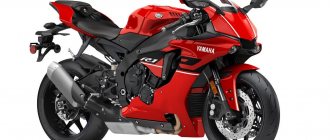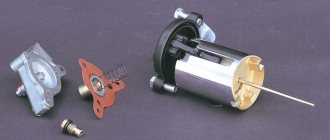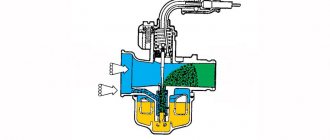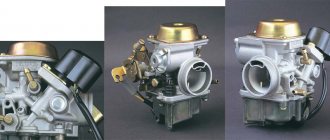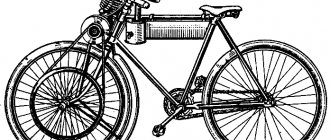Motocross tracks are usually quite long (1.5-3 km) and include natural obstacles with various variations of specially created jumps and other man-made elements. In history, there has never been a track that consisted of hills and turns, without a single jump. Supercross, as a type of motocross, is an entirely man-made track, usually of short length with a large number of jumps and turns, built in stadiums (sometimes indoors).
Due to the size of the track, motocross typically has 40 riders, while supercross has about 25.
Races vary in length, usually measured by time plus 1-2 laps. Grand Prix (GP) or American Champion (Pro AMA) usually takes place within 30 minutes + 2 laps. Amateur races usually take much less, about 10 minutes. When the appointed time arrives, the finish line man signals to the racers that there is one (or two) laps left, and then the race ends with the waving of the checkered flag. Other off-road varieties such as Enduro (almost the same as motocross, only the races take place on a large natural track, and take place much longer and at higher speeds). There a certain number of laps is set or simply a maximum time limit.
Races take place in heats. Usually the race includes two races, the results of which are determined by the final.
general information
Motocross is a type of off-road racing. Competitions are held on specially organized closed tracks 1.5-2 km long, which do not include sections of public roads. They have a natural surface and are necessarily equipped with additional obstacles such as uneven terrain or small jumps. Depending on the scale of the competition, the race is held in 2-3 heats, each of which takes an average of 20-40 minutes + 2 additional laps.
Participants use special equipment and special motocross models of motorcycles, depending on the engine size of which the races are divided into classes. At the same time, existing classes and specific equipment requirements within each of them are indicated for each championship separately.
You can learn more about the design features of a cross-country motorcycle from one of the previous materials.
Where did motocross begin?
The very first competition that laid the foundation for motocross is the “Fox Race” in 1908. Not only motorcyclists, but also horse riders took part in it. This set of participants, so strange for a modern viewer, can be explained quite simply: the purpose of the race was to prove that motorcycles can compete on an equal footing with horses in speed and cross-country ability. Despite the fact that the motorcyclists were defeated in this race (11 out of 13 participants did not finish), off-road motorcycle racing continued to exist and develop.
As a result, all this resulted in the emergence of the first official international competition - the European Motocross Championship, held in 1952. In 1957 it was replaced by an even larger World Championship, held under the auspices of the FIM to this day.
In the USSR, cross-country races, despite a fairly strong technical lag behind the West, gained official status already in 1928, when the cross-country race became part of the Spartakiad. The first international competitions took place in 1954. Not only Soviet racers took part in them, but also athletes from Czechoslovakia, Poland and the GDR. And already 2 years later, the Central Automobile Club of the USSR was officially accepted by the FIM, which opened up access to world competitions for domestic motorcyclists.
Controls
| This section uses abbreviations that may be confusing or ambiguous. This issue may be discussed on the talk page. |
Motocross is regulated worldwide by the Fédération Internationale de Motocyclisme (FIM), with federations in many countries.
- Australia - Motorsport Australia (MA)
- Austria - Osterreichische Automobil, Motorrad und Touring Club (OAMTC)
- Belgium - Belgian Motorcycle Federation (FMB)
- Brazil - Brazilian Confederation of Motorcycling (CBM)
- Canada - Canadian Motorsport Racing Corp. (CMRC) and Canadian Motorcycle Association (CMA)
- Czech Republic – Autoklub České republiky (ACCR)
- Denmark - Danmarks Motor Union (DMU)
- Estonia – Eesti Motorrattaspordi Föderatsioon (EMF)
- Finland – Suomen Moottoriliitto (SML)
- France - French Motorcycle Federation (FFM)
- Germany - Deutscher Motor Sport Bund (DMSB)
- India - Federation of Motor Sports Clubs of India (FMSCI)
- Ireland - Motorcycle Union of Ireland (MCUI) - NB island wide
- Italy – Federazione Motociclistica Italiana (FMI)
- Latvia – Latvijas Motosporta Federācija[22] (LaMSF)
- Lithuania – Lietuvos Motociklų Sporto Federacija (LMSF)
- Netherlands - Koninklijke Nederlandse Motorrijdersvereniging (KNMV), Motorsport Organisatie Nederland (MON)
- New Zealand - Motorsport New Zealand (MNZ) and the New Zealand Dirt Motorcycle Federation
- Norway – Norges Motorsportforbund (NMF)
- Poland – Polski Związek Motorowy (PZM)
- Portugal – Federação Motociclismo Portugal (FMP)
- Russia - Motorcycle Federation of Russia (MFR)
- South Africa - Motorsport South Africa (MSA)
- Spain – Real Federación Motociclista Española (RFME)
- Slovenia – Autocycle Union of Slovenia (AMZS)
- Sweden – SVEMO
- Switzerland - Swiss Motorcycle Federation (FMS)
- Thailand - Federation of Motor Sports Clubs of Thailand (FMSCT)
- United Kingdom - Auto-Cycle Union (ACU), with other separate bodies such as the Amateur Motorsports Association (AMCA), ORPA, BSMA, and YSMA.
- United States - American Motorcycle Association (AMA)
Main competitions
Almost from the very beginning of its existence, motocross was the most accessible entry point into the world of professional sports, so there were always enough participants, and a huge number of competitions of various sizes took place. In addition to the World Championship, the main world competitions also include:
- AMA Motocross Championship is an American championship founded by the American Motorcycle Association in 1972. The winners are determined in 3 classes: 450, 250 and Women's MX - a hotel classification for women.
- BritishMotocrossChampionship is the main British championship, held under the auspices of Auto-CycleUnion (ACU) and one of the largest motorcycle tire manufacturers, Maxxis.
- MotocrossdesNations is a team competition that has been held regularly since 1947. Today there are 3 independent races under this name: the original Motocross of Nations (500 class), TrophéedesNations (250 class) and CoupedesNations (125 class).
- The European Championship has existed since 1988 and today is held in 5 classes: EMX250, EMX125, EMX2T (motorcycles with 2-stroke 250 cm3 engines), EMX85, EMX65.
Most major countries that compete internationally also have local races. In Russia it is:
- Russian championship,
- Cup of Russia,
- Russian Cup among women,
- Federal District Championships,
- MFR Cup and others.
A more detailed list of domestic competitions, as well as the current results of past races, can also be found here.
Equipment
Motocross motorcycle
Main manufacturers
|
|
|
Minor
|
|
|
- (Italy), TM has the largest market share of motocross bikes outside of the main six.
Niche manufacturers in the market
|
|
|
Chinese manufacturers
|
|
Manufacturers who have stopped production
|
|
|
Types of motocross racing
Over the century of its existence, motocross has managed not only to form into a “classical” discipline, but also to become the basis for the emergence of a whole series of varieties of motocross racing, some of which were even eventually officially recognized as separate sports.
- Supercross (stadium cross) - While "classic" motocross tracks are laid out in open areas, supercross is always held in large stadiums. The first such race was organized in 1972. Due to the smaller scale of the event itself, the length of the route and the number of participants were significantly reduced. The length of the “circle” is at least 400 and 300 m in open and indoor stadiums, respectively. The total number of participants is about 25 versus 40 in motocross; more athletes will be uncomfortable and unsafe on the track. Check-in time is also reduced and depends on the class of participants. On average it is 10-30 minutes with 1 or 2 additional laps.
- Arenacross is a complete analogue of stadium cross, but held in even more compact arenas. Typically, such competitions are organized in small cities where it is not possible to hold a “full” race. The first arenacross competitions were held only in 2006, but now they are quite popular in America and are even used as an opportunity for amateurs to join the ranks of professional athletes.
- Motocross on motorcycles with a sidecar is another analogue of classic motocross, in which teams of 2 people take part - a driver and a sidecar rider. The main function of the latter is to prevent the machine from tipping over when passing obstacles and turns by moving its own weight. The first mention of this sport dates back to the 1930s, but now it is official: the World Championship has been held under the auspices of the FIM since 1980. In Russia, competitions are officially accepted in 2 classes: 500 and 750.
- Motocross on ATVs is a competition on motocross tracks held on ATVs according to the rules of motocross.
- Motocross on snowmobiles is a “winter version” of motocross on ATVs.
- Pit bike (mini-motocross) – motocross races on compact motorcycles (pit bikes) built on the basis of 4-stroke 50 cm3 engines. At the moment, pit bike is not included in the All-Russian Register of Sports (VRVS), that is, it is not officially considered a sports discipline in Russia. At the same time, the American Motorcycle Association has already included mini-motocross in its registry.
A little history
To begin with, it is worth focusing on why it is necessary to divide competitions into classes in motocross. It is based on the motorcycle used, or more precisely, its parameters.
Initially, standard road motorcycles were used for competitions, but with the development of sports and the automotive industry, it became clear that this solution was far from optimal.
Firstly, due to the fact that the route was guaranteed to include obstacles, the load on the motorcycle inevitably increased, which led to constant breakdowns. In particular, the exhaust pipe suffered the most, inevitably receiving damage when overcoming jumps, as well as mirrors and headlights - the most fragile components that suffer when athletes fall.
Secondly, the overall weight of the structure began to play a big role - the smaller it was, the more useful power could be obtained from the engine, and the easier it was for the rider to control the motorcycle. In this regard, it was decided to discard parts that were useless in this case. These include the entire electrical part and the most fragile structural elements.
The most important design change was the installation of special motor models, during the design of which they tried to achieve two goals:
- make the motor lighter, since its effect on the overall weight was the strongest,
- bring torque to the forefront rather than top speed, as drivers needed more confident performance of the cars on difficult sections.
So, a fairly impressive number of models began to come out of the assembly lines of manufacturers producing serial motocross motorcycles, differing in the installed engine and, as a result, power. And since motocross has long been considered an official sport, it was necessary to strictly delimit their use in order to achieve maximum fairness of competitions and equality of athletes.
